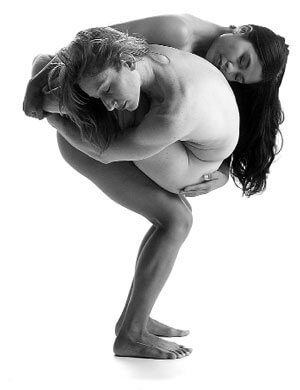Pilobolus’ Joyce stint remains choreographically intimate, technically stellar
By GUS SOLOMONS, JR.
At the Joyce Theater, if it’s summer, it’s Pilobolus in the company’s annual four-week sojourn, this year through July 17.
This 34-year-old performing institution began in a dance studio at Dartmouth University, when a bunch of guys started playing around with the laws of physics and each other, getting into such intimate physical positions it’s hard to believe they were straight––or maybe impossible to believe they weren’t. Their moves include nestling chins on crotches, tramping on each other’s faces, and hefting each other around by every conceivable part of their athletic bodies.
Co-artistic directors Robby Barnett, Allison Chase, Michael Tracy, and Jonathan Wolken have long since run out of new ideas, but like most prolific artists who have found the keys to their audiences’ hearts, they continue to mine their theatrical imaginations, turning out new dances with a small repertoire of impressive physical stunts, done in endless variations––two-person, four-legged traveling; supported, slow-motion flips; creature-like composites of intertwined bodies; and consistently mysterious lighting effects by Stephen Strawbridge and Neil Peter Jampolis.
The New York premiere in Program C, “Warm Heart” by Michael Tracy in collaboration with Jennifer Macavinta and Manelich Minniefee, begins with the couple, center stage, chasing each other’s tails, then widening their circle, full stage. To ambient music by Aphex Twin, the couple pretends to balance on rocks in an imaginary stream: she’s frightened, he rescues her. When she freezes in terror, he manipulates her rigid body. She melts, and he has to keep holding her up. Then, she sticks to him like Velcro, wrapping herself around his head and shoulders in tricky lifts. It’s a kind of love story.
Also by Tracy, “My Brother’s Keeper” (2003), a quartet for Mark Fucik, Renée Jaworski, Matthew Thornton, and Minniefee counterpoints two couples––one pair skims over each other’s backs, the other lifts vertically; the lighter partners drape over their stronger partner’s heads like human hoods. Endless repetition, however, blunts the initial novelty of the coupling.
“Tsu-Ku-Tsu” (2000) by Chase and the dancers, set to a score of Japanese drumming by Leonard Eto, reflects its Asian flavor with Angelina Avallone’s mini kimonos in subtle hues and the glacial movement pace––women stand on the crouching men’s back, as they inch across the stage. Egalitarian Chase gives everyone solo moments and acrobatic, twining duets.
The one in which Andrew Herro and Minniefee cartwheel, alternating with precarious suspended flips, draws a round of appreciative applause for its riskiness and smooth execution. Another spectacular lift rates an instant ovation––four dancers wedge their heads between the powerful thighs of Thornton and Fucik, feet radiating out like rays of a mythical sunburst.
The program closes with a Pilobolus classic. Created in 1975 by the four directors plus founding members Martha Clarke and Moses Pendleton, “Untitled” epitomizes the bizarre imagination that built the company’s reputation. Two courtly Victorian ladies in elegant costumes by Kitty Daly and Malcolm McCormick suddenly grow ten feet tall, alarming a pair of potential suitors that happen by. After a staid courtship minuet, the women give birth to nude men (on whose shoulders they’d been riding under their luxurious skirts.)
Such whimsical physical transformations, provocative nudity, and wonderfully weird imagery remain the forte of Pilobolus at its best.
The dances explore varied visual moods, but they all remain ponderous in their pacing. Perhaps unlimited rehearsal time in their idyllic, rural Connecticut headquarters encourages them to indulge, showing us everything they made rather than just the best of it. Still, if you haven’t seen Pilobolus, do. If you have, don’t expect any big surprises, but this middle-aged troupe, named for a fungus, still appeals broadly to dance fanatics and novices alike.


































